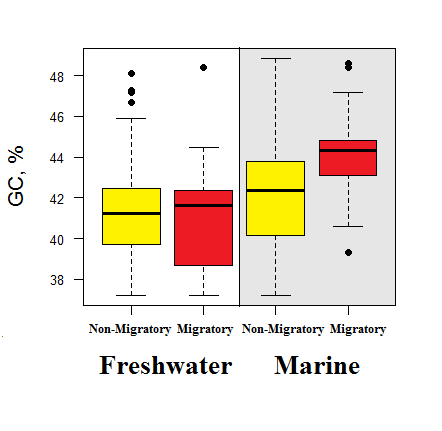The fish response (unveiled by a SZN study)
 The four nucleotides (Adenine, Thymine, Guanine and Cytosine) within the DNA molecule are ordered to encode the information the cell needs for building proteins. It has been shown that the structural stiffness of DNA is determined by the nucleotide ratio within the molecule, also called Guanine+Cytosine content (GC). Can it be evolutionary advantageous to be GC-rich? It seems so, since a GC-rich DNA takes advantage of its larger flexibility to be more suitable to the torsional stress during the transcriptional processes. A study carried out at the SZN BEOM department compared more than five hundred bony fish species to highlight a link between GC-concentration and metabolism. This study found higher GC values in marine versus freshwater species. A similar trend was observed between migratory and non-migratory species, the latter characterized by larger gill area and higher metabolic rate (See Figure).
The four nucleotides (Adenine, Thymine, Guanine and Cytosine) within the DNA molecule are ordered to encode the information the cell needs for building proteins. It has been shown that the structural stiffness of DNA is determined by the nucleotide ratio within the molecule, also called Guanine+Cytosine content (GC). Can it be evolutionary advantageous to be GC-rich? It seems so, since a GC-rich DNA takes advantage of its larger flexibility to be more suitable to the torsional stress during the transcriptional processes. A study carried out at the SZN BEOM department compared more than five hundred bony fish species to highlight a link between GC-concentration and metabolism. This study found higher GC values in marine versus freshwater species. A similar trend was observed between migratory and non-migratory species, the latter characterized by larger gill area and higher metabolic rate (See Figure).
The hypothesis was confirmed in the model species for which genomes were available, identifying the link between GC-richer regions and higher transcription. At the same time, the non-coding DNA of those genes (i.e. introns), were also studied, bringing to light that these regions shorten in species with higher levels of transcription and increasing metabolic rates.
The above observations imply that the structure of the DNA itself and its nucleotide concentration are under natural selection for higher metabolic rate. This introduces a new hypothesis to evolutionary genomics in marine organisms, challenging the traditional view of a neutral evolution.
Further info here:
http://journals.plos.org/plosone/article?id=10.1371/journal.pone.0103889
http://bmcgenomics.biomedcentral.com/articles/10.1186/s12864-016-2537-1










